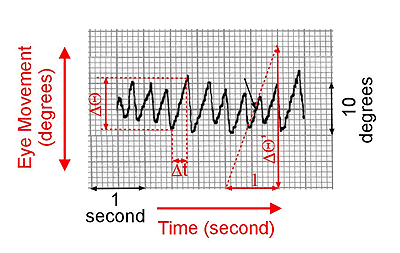Question
How does one calculate the maximum slow phase velocity of a nystagmus beat?
Answer
During ENG, the examiner needs to know the nystagmus intensity to correctly interpret the findings. Most computerized systems automate this task but there are times when the examiner has to manually measure the intensity. Those measurements are usually required only when the nystagmus has clear fast and slow phases. The following figure shows an example of horizontal nystagmus with rightward slow phases and leftward fast phases. This is referred to as leftbeating since nystagmus is identified by its fast phases.
The nystagmus intensity is defined as the slow-phase velocity (SPV). To measure SPV for one nystagmus beat, the examiner has to determine the distance that the eye travels during the slow phase and divide that by the amount of time (SPV = ΔΘ/Δt). An easier method is to draw a line that best fits the slow phase of the nystagmus and measure the slope of this line. That way, the eye movement can be measured for a preset time, usually one second (SPV = ΔΘ'/1). To complete the process, the examiner must know the scale of the time and eye movement axes. These values are determined by the equipment setting and during the calibration. In this example, 10 blocks represent 1 second on the time axis and 10 blocks represent 10 degrees on the eye movement axis. The SPV for the nystagmus beat identified by the arrow is:
SPV = 27 degrees / 1 second = 27 degrees/second.

As it is clear from this discussion, "maximum slow phase velocity" is meaningful only when we are talking about a series of nystagmus beats (such as caloric responses) and not just one. To find the maximum or peak nystagmus response, the examiner should draw a line for each nystagmus beat (or at least a few representative ones). The lines with the steepest slope represent the nystagmus beats with the highest velocities. In caloric testing, usually 3-5 nystagmus beats with the highest SPV¡¦s are averaged to get an estimate of the peak caloric response. Again the computerized systems automate this task.
Kamran Barin is the Director of the Balance Disorders Clinic at the Ohio State University, Department of Otolaryngology. He has taught national, international, and graduate level courses in vestibular function testing since 1983.

